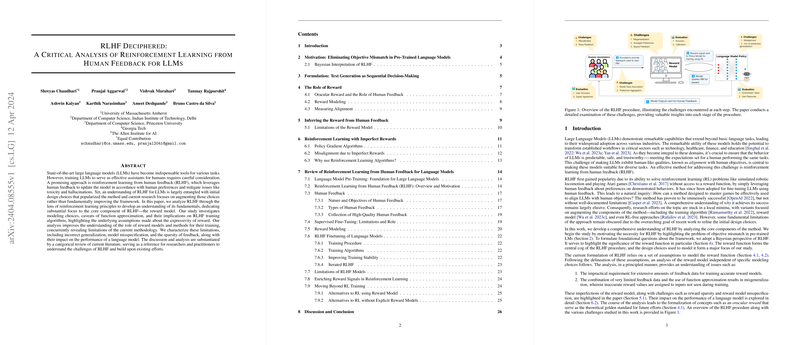Comprehensive Analysis of Reinforcement Learning from Human Feedback in LLMs
Introduction to RLHF and Its Importance
Reinforcement Learning from Human Feedback (RLHF) has emerged as a pivotal technique in aligning LLMs with human intentions and preferences. The method extends beyond standard reinforcement learning frameworks by actively incorporating human evaluative feedback into the learning process. Research on RLHF has primarily concentrated on improving LLMs' behavior, tackling tasks where human-like behavior, trustworthiness, and safety are paramount.
Theoretic Underpinnings and Practical Implications
Foundations of RLHF:
RLHF introduces a unique method of fine-tuning LLMs that leverages human feedback to directly shape the model’s outputs. The approach is underpinned by three primary components:
- Feedback Collection: Gathering human evaluations on model outputs, ranking them, or providing constructive language feedback.
- Reward Model Training: Developing a model that predicts how well an output aligns with human preferences, based on the collected feedback.
- Model Fine-Tuning: Utilizing reinforcement learning algorithms to adjust the LLM’s parameters such that outputs that are better aligned with human preferences are more likely to be produced.
Challenges and Limitations:
The paper meticulously discusses several significant challenges associated with RLHF:
- Model Misgeneralization: The divergence in performance when faced with novel inputs not covered in the training set.
- Reward Sparsity: The inadequacy of frequent and immediate feedback throughout the output generation process, which complicates the training dynamics.
- Reward Model Generalization: Ensuring that the reward model generalizes effectively from its training data to unseen examples is critical yet challenging, often requiring iterative refinement and extensive validation against human judgment.
Future Directions in RLHF Research
The future of RLHF promises several intriguing research avenues. One critical area involves refining the reward models to address issues like incorrect generalizations and integration of more nuanced forms of feedback that capture a broader range of human preferences. Moreover, exploring methodologies to reduce the dependency on extensive human feedback by utilizing unsupervised or semi-supervised techniques could broaden the applicability and efficiency of RLHF.
Another prospective development could focus on the incorporation of multi-objective optimization frameworks that allow simultaneous tuning of multiple aspects of model outputs, such as factual accuracy and user engagement, without compromising one for the other.
Conclusion
This paper offers an enriched understanding of the RLHF process, elucidating its contribution to the development of more human-aligned LLMs. Not only does it highlight current achievements and limitations, but it also paves the path for future research that could potentially revolutionize how we fine-tune and deploy LLMs in various real-world applications. Given the complexity of human language and communication, the journey of refining RLHF is poised to be both challenging and rewarding, with substantial implications for AI's role in society.
